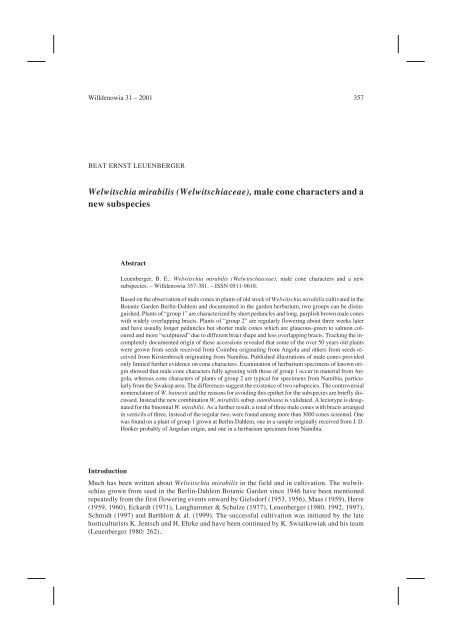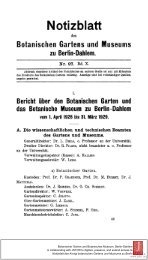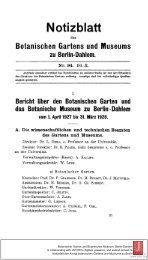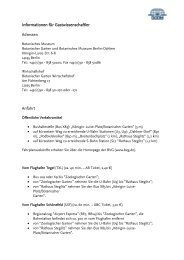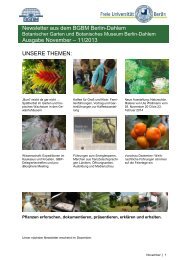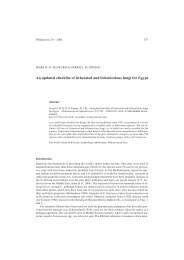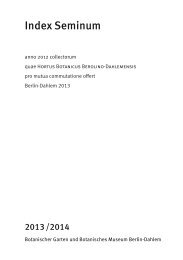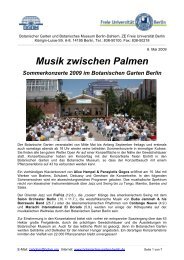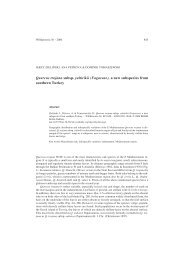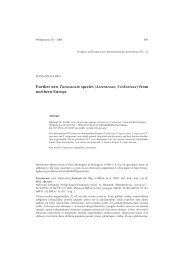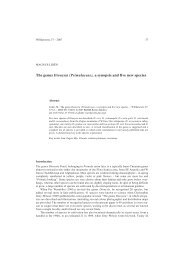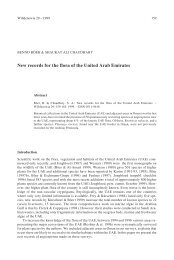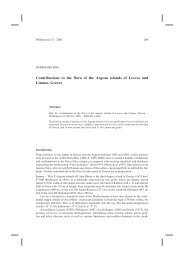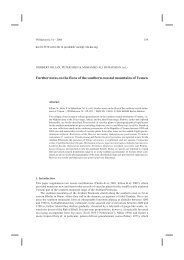Welwitschia mirabilis - Botanischer Garten und Botanisches ...
Welwitschia mirabilis - Botanischer Garten und Botanisches ...
Welwitschia mirabilis - Botanischer Garten und Botanisches ...
You also want an ePaper? Increase the reach of your titles
YUMPU automatically turns print PDFs into web optimized ePapers that Google loves.
Willdenowia 31 – 2001 357<br />
BEAT ERNST LEUENBERGER<br />
<strong>Welwitschia</strong> <strong>mirabilis</strong> (<strong>Welwitschia</strong>ceae), male cone characters and a<br />
new subspecies<br />
Abstract<br />
Leuenberger, B. E.: <strong>Welwitschia</strong> <strong>mirabilis</strong> (<strong>Welwitschia</strong>ceae), male cone characters and a new<br />
subspecies. – Willdenowia 357-381. – ISSN 0511-9618.<br />
Based on the observation of male cones in plants of old stock of <strong>Welwitschia</strong> <strong>mirabilis</strong> cultivated in the<br />
Botanic Garden Berlin-Dahlem and documented in the garden herbarium, two groups can be distinguished.<br />
Plants of “group 1” are characterized by short peduncles and long, purplish brown male cones<br />
with widely overlapping bracts. Plants of “group 2” are regularly flowering about three weeks later<br />
and have usually longer peduncles but shorter male cones which are glaucous-green to salmon coloured<br />
and more “sculptured” due to different bract shape and less overlapping bracts. Tracking the incompletely<br />
documented origin of these accessions revealed that some of the over 50 years old plants<br />
were grown from seeds received from Coimbra originating from Angola and others from seeds received<br />
from Kirstenbosch originating from Namibia. Published illustrations of male cones provided<br />
only limited further evidence on cone characters. Examination of herbarium specimens of known origin<br />
showed that male cone characters fully agreeing with those of group 1 occur in material from Angola,<br />
whereas cone characters of plants of group 2 are typical for specimens from Namibia, particularly<br />
from the Swakop area. The differences suggest the existence of two subspecies. The controversial<br />
nomenclature of W. bainesii and the reasons for avoiding this epithet for the subspecies are briefly discussed.<br />
Instead the new combination W. <strong>mirabilis</strong> subsp. namibiana is validated. A lectotype is designated<br />
for the binomial W. <strong>mirabilis</strong>. As a further result, a total of three male cones with bracts arranged<br />
in verticils of three, instead of the regular two, were fo<strong>und</strong> among more than 3000 cones screened. One<br />
was fo<strong>und</strong> on a plant of group 1 grown at Berlin-Dahlem, one in a sample originally received from J. D.<br />
Hooker probably of Angolan origin, and one in a herbarium specimen from Namibia.<br />
Introduction<br />
Much has been written about <strong>Welwitschia</strong> <strong>mirabilis</strong> in the field and in cultivation. The welwitschias<br />
grown from seed in the Berlin-Dahlem Botanic Garden since 1946 have been mentioned<br />
repeatedly from the first flowering events onward by Gielsdorf (1953, 1956), Maas (1959), Herre<br />
(1959, 1960), Eckardt (1971), Langhammer & Schulze (1977), Leuenberger (1980, 1992, 1997),<br />
Schmidt (1997) and Barthlott & al. (1999). The successful cultivation was initiated by the late<br />
horticulturists K. Jentsch and H. Ehrke and have been continued by K. Swiatkowiak and his team<br />
(Leuenberger 1980: 262).
358 Leuenberger: <strong>Welwitschia</strong> <strong>mirabilis</strong>, male cone characters and a new subspecies<br />
Fig. 1. <strong>Welwitschia</strong> <strong>mirabilis</strong>, cult. hort. Bot. Berol.; comparison of male flowering plants, inflorescences and<br />
male cones – a, c, e: group 1 (note the advanced stage of development); b, d, f: group 2 (inset in f showing<br />
cones at a stage of maturity comparable to that of Fig. 1e). – Photos a and e of plant no. 2; b of plant no. 6; c<br />
of plant no. 12; d and f of plant no. 3; all photographs by the author.<br />
Published observations on the variation of <strong>Welwitschia</strong> refer particularly to vegetative features.<br />
Based on the observation of seedlings grown at Kirstenbosch, Van Jaarsveld (1990: 72)<br />
noted the “great genotypic variation of seedlings” from the Koigab river in north central
Willdenowia 31 – 2001 359<br />
Namibia. He concluded that “this variability is probably one of the reasons why <strong>Welwitschia</strong> is<br />
still common and such a highly successful plant”. In Namibia, Willert (1993) fo<strong>und</strong> two whorls<br />
of leaves in about 5 % of all plants in the Brandberg area. Detailed studies on some populations<br />
exist. Eller & al. (1983) counted 113 male plants among 215 flowering welwitschias in a study<br />
area east of Swakopm<strong>und</strong>. The same population was monitored by Brinckmann & Willert (1987).<br />
Measurements of leaf growth made by Moisel were published by Walter & Breckle (1984, 1991).<br />
Whellan (1965) provided much information on the ecology and on populations of <strong>Welwitschia</strong><br />
observed in 1963 between Moçamedes and Virei (Birei) in Angola, where he estimated the existence<br />
of several million plants in an area smaller than 1600 square kilometers, which is only<br />
about 2-3 % of the total range of the species. Wetschnig (1997) calculated the population size on<br />
the <strong>Welwitschia</strong>vlakte in Namibia to be 5000-6000 individuals. Both in Angola and in Namibia,<br />
large parts of its range are within national parks (IUCN/UNEP 1987). The species is not listed<br />
anymore among especially threatened species (Walters & Gillett 1998). Willert (1994) contributed<br />
important biological observations and ecological data from the field (see also Willert 2000).<br />
Wetschnig (1997) observed and documented bee pollination. Henschel & Seely (2000) reported<br />
about long-term ecological research on a far southern population near Gobabeb, Namibia. This<br />
work is complemented by a bibliography containing 297 papers on <strong>Welwitschia</strong> (Henschel&al.<br />
2000).<br />
Variation in cone characters, in contrast, does not appear to have caught the attention of authors<br />
doing research on <strong>Welwitschia</strong> or publishing reports from the field or notes on the cultivation. In<br />
pub- lications of J. D. Hooker (1862, 1863), W. J. Hooker (1863), Groenland (1863), McNab<br />
(1873), Dinter (1898), Anonymous (1898), Baum (1903), Sykes (1910), Takeda (1913), Markgraf<br />
(1926), Pearson (1929), Chamberlain (1934), Herre (1948, 1954), Hall (1950), Rodin (1953a-b,<br />
1963), Jensen (1957), Martens (1961, 1971), Whellan (1965), Friedrich-Holzhammer & Roessler<br />
(1966), Verdoorn (1966), Kers (1967), Giess (1969), Benson (1970a-b), Horwood (1974), Zecher<br />
(1974), Martens (1977), Bornman (1977, 1978), Tijmens (1978), Eller & al. (1983), Willert (1985,<br />
1993, 1994), Brinckmann & Willert (1987), Kedves (1987), Van Jaarsveld (1990, 1992), Kubitzki<br />
(1990), Leute & Wetschnig (1990), Kärnefelt (1994), Wetschnig (1997), Steyn & Smith (1999),<br />
Lombardi (2000), Schnabel (2000a-b) and Van Jaarsveld & Linder Smith (2001) no particular<br />
mention of variation of characters of inflorescences or male cones was made.<br />
Carrière (1867) treated <strong>Welwitschia</strong> bainesii as second though still somewhat doubtful species<br />
besides W. <strong>mirabilis</strong>, stating as possible differences shorter trunks, four leaves and trichotomous<br />
panicles for W. bainesii. Eichler (1887) mentioned, in a footnote, an oral report by<br />
Pechuel-Lösche on plants in the “Hereroland” (N Namibia) with yellowish cones. Pearson<br />
(1929) interpreted these as mature seed cones.<br />
Rodin (1963) studied particularly the anatomy of the male bracts based on a collection from<br />
Namibia. The very comprehensive anatomical and morphological study of Martens (1971: 73-<br />
168) provided most detailed information on flower characters, but the variation of cone and bract<br />
features was not addressed.<br />
Berlin-Dahlem is one of the few gardens besides Kirstenbosch, where several plants of <strong>Welwitschia</strong><br />
<strong>mirabilis</strong> can be observed in flower side-by-side. The old stock plants are over 50 years<br />
old and were all grown from seed. Numerous plants of second generation exist as well, and the<br />
first of these have flowered already. Thirteen plants in the <strong>Welwitschia</strong> house in the nursery, and<br />
two in the display glasshouse have trunk diameters between 15 and 45 cm and leaf widths between<br />
16 and 61 cm. Of these, eight produce male cones, four have at least once produced female<br />
cones, three have not flowered yet. Surprisingly, the two old plants in the Welwitscha annex<br />
grown <strong>und</strong>er more arid conditions, supposedly more appropriate in comparison with the natural<br />
habitat in Namibia, have only shown initial signs of inflorescence formation on the meristematic<br />
ridges, but have not developed peduncles and cones yet. This is possibly due to the lack of an <strong>und</strong>ergro<strong>und</strong><br />
heating system in this glasshouse. A constant soil temperature of c. 26 °C maintained<br />
in the glasshouse in the nursery has proved to be highly beneficial for successful growth and profuse<br />
flowering of our W. <strong>mirabilis</strong>. In 1995 the largest plants of the old stock of W. <strong>mirabilis</strong> were
360 Leuenberger: <strong>Welwitschia</strong> <strong>mirabilis</strong>, male cone characters and a new subspecies<br />
provided with individual numbers (1-13) to keep records and garden herbarium voucher specimens<br />
separate. The numbering of individuals has been recently extended to all 16 <strong>Welwitschia</strong><br />
plants of the old stock for further monitoring.<br />
Observations on male <strong>Welwitschia</strong> plants cultivated in Berlin-Dahlem<br />
Mr Kurt Swiatkowiak, horticulturist working with the <strong>Welwitschia</strong> collection at Berlin-Dahlem<br />
since 1964, first observed differences in flowering period and male cone characters between individual<br />
plants among simultaneously flowering male welwitschias. His repeated observations<br />
on peduncle length, shape and colour of the male cones led the author to attempt a closer look<br />
some years ago. However, the lack of exact documentation of the origin of the plants of the old<br />
and presumably heterogeneous stock was taken as a major impediment for a systematic approach<br />
to such a study. Nevertheless, in 1993 the author consulted the first and preliminary observations<br />
with E. van Jaarsveld of the Kirstenbosch Botanic Garden, where numerous large plants of <strong>Welwitschia</strong><br />
<strong>mirabilis</strong> originating from Namibia are cultivated (see also Van Jaarsveld 1990: 74[upper<br />
left], 2000). No observations suggesting particular differences between male cones of<br />
different plants of one accession or between plants of different origin had been made at<br />
Kirstenbosch (Van Jaarsveld, pers. comm. 1993). Only much later, an illustration of flowering<br />
male plants from Namibia by Van Jaarsveld (1992: 119), well compatible with those of group 2<br />
at Berlin-Dahlem, came to the attention of the author. This was a further stimulus to search for<br />
more data by repeated observations, comparison with plants illustrated in literature and with herbarium<br />
material of known origin.<br />
The observation suggested that the old stock at Berlin-Dahlem is composed of two groups of<br />
plants, denominated here as “group 1” and “group 2” (Tables 1 and 2) . Group 1 comprises plants<br />
no. 2, 8, 9, 11 and 12 (Fig. 1a, c, e, 2b, 3a, 4a, c, e, 5), group 2 consists of plants no. 3, 6 and 7<br />
(Fig. 1b, d, f, 2c, 3b, 4b, d, f, 6). The five plants of group 1, including the three largest specimens,<br />
regularly produce their inflorescences about three weeks before the regularly flowering plants<br />
no. 3 and 6 of group 2. The differences in the length of the peduncles were first thought to be the<br />
most conspicuous feature, but this character alone does not permit to distinguish two clear-cut<br />
groups, as there is considerable overlap (Table 1).<br />
The flowering period seems to be fairly constant. At full flowering stage of plants of group 1<br />
(Fig. 1a, c, e), plants of group 2 only just start to flower (Fig. 1b, d, f). The inset in Fig. 1f shows a<br />
cone at a flowering stage comparable to that shown in Fig. 1e. It also demonstrates the importance<br />
of looking at comparable stages of development to appreciate the morphological differences in<br />
male cones.<br />
Group 1 – The five plants of group 1 produce purplish brown male cones with rather smooth and<br />
thin, laterally very widely overlapping bracts with rather smooth surface and margin (Fig. 2b, 3a,<br />
4a). Three of these plants flower regularly and profusely. Plant no. 8, an exceptional specimen<br />
Table 1. Peduncle and branch lengths (in cm) in male inflorescences in six individuals of <strong>Welwitschia</strong> <strong>mirabilis</strong><br />
cultivated at Berlin-Dahlem<br />
<strong>Welwitschia</strong> group 1 <strong>Welwitschia</strong> group 2<br />
pl. no. 2 pl. no. 9 pl. no. 11 pl. no. 12 pl. no. 3 pl. no. 6<br />
Secondary<br />
branches<br />
0-2 0-2 0 0-7 0-5 0-7<br />
Primary<br />
branches<br />
2-9 2-7 2-5 2-9 7-9 6-9<br />
Peduncle 5-9 2-11 3-10 7-11 10-15 6-14
Willdenowia 31 – 2001 361<br />
Fig. 2. <strong>Welwitschia</strong> <strong>mirabilis</strong>, comparison of male cones of cultivated and field-collected specimens – a-b:<br />
group 1; c-d: group 2; a: from Brühl 44 (B) from Angola; b: from cult. plant no. 2; c: from cult. plant no. 6; d:<br />
from Werdermann & Oberdieck 2428/2429 (B) from Namibia. – Scale 5 mm; photograph by M. Lüchow.<br />
with one additional median leaf, only produced few inflorescences since 1991. In 2000, only two<br />
inflorescences not suitable for quantitative comparison were formed, but the plant clearly belongs<br />
to group 1.<br />
In summer 2000, the number of inflorescences per plant ranged from 2 to 96. The largest<br />
plant (no. 12) produced 80 male inflorescences with most peduncles about 7 to 11 cm long and<br />
with a total of 2730 cones. From the shed inflorescences of this plant (partly kept in the garden<br />
herbarium, Cubr 26183a), a random selection of 315 male cones were measured. The broad variation<br />
of cone length (15-42 mm) in plant no. 12 is shown together with that of other plants of<br />
group 1 (Fig. 5). The inflorescences of no. 11 are possibly exceptional because this plant is currently<br />
growing in partial shade of a large leaf of a neighbouring plant. The cones are weaker and<br />
shorter, but on average still longer than those of plant no. 3, and equal the longer cones of plant<br />
no. 6 of group 2 (Fig. 5-6). Cone measurements of plant no. 12 (group 1) is taken as representative<br />
for comparison with field collected material (Fig. 7, 9). The cone length alone is not sufficient<br />
to distinguish between the two groups.
362 Leuenberger: <strong>Welwitschia</strong> <strong>mirabilis</strong>, male cone characters and a new subspecies<br />
Table 2. Male cone characters of <strong>Welwitschia</strong> plants cultivated at Berlin-Dahlem (see also Fig. 1-6).<br />
Characters Group 1: plants no. 2, 8, 9, 11, 12;<br />
measurements from no. 2, 9, 11<br />
and 12<br />
Group 2: plants no. 3, 6, 7;<br />
measurements from no. 3 and 6<br />
Flowering early July to mid August late July to late September<br />
Shedding of male inflorescences late August December to January<br />
Number of male inflorescences 2-96 2-7<br />
Peduncle length [cm] (only well<br />
developed inflorescences with<br />
several cones)<br />
(3-)6-1 (6-)9-15<br />
Cone length [mm] (11-)22-45 10-30<br />
Cone colour purplish brown (green when<br />
shaded)<br />
glaucous-green to glaucoussalmon<br />
(green when shaded)<br />
Cone surface rather smooth sculptured<br />
Wax on peduncles, bracts and<br />
floral bracts<br />
absent to the naked eye usually conspicuous at least at<br />
the base of the cones<br />
Bract pairs, position overlapping to c. 2 mm overlapping to c. 1 mm<br />
Bract pairs, shape deeply cupular saucer-shaped<br />
Bracts, outer surface smooth slightly rugose<br />
Apex of bracts not pronounced pronounced, slightly keeled<br />
Bract margin smooth to slightly erose, not<br />
angled<br />
usually erose, angled<br />
Fusion zone of bracts 2.5 mm high 1 mm high<br />
Upper margin of fusion zone 0.5-1 mm broad 2-3 mm broad<br />
Another feature of the group 1 plants not recorded hitherto is the ab<strong>und</strong>ant presence of a pigment,<br />
probably anthocyan, in the epidermis of the bracts of the cones. The pigment is soluble and<br />
reddish brown in alcoholic solution. The reddish brownish colour of the cones is visible in numerous<br />
illustrations, as discussed below.<br />
Group 2 – Our three plants with glaucous-green male cones and more sculptured surface (plants<br />
no. 3, 6 and 7) produce on average fewer inflorescences with longer peduncles but shorter cones<br />
ranging between 10 and 26 mm length (Fig. 1b, 2c). A diagram with cone measurements of two<br />
plants of group 2 is shown in Fig. 6. Inflorescences of plant no. 7 were observed and photographed<br />
in 1993 and coincide perfectly with plants no. 3 and 6.<br />
The male cones of all three plants are pale greenish grey when young but turn salmon coloured<br />
with a glaucous hue at maturity, caused by a wax cover which is particularly conspicuous<br />
on the basal bracts but sometimes extends to the whole cone. The presence of wax on the leaf epidermis<br />
of <strong>Welwitschia</strong> was illustrated by Barthlott & Ehler (1977) and mentioned for specimens<br />
from Namibia by Wilhelmi & Barthlott (1997), whereas wax on the cones has not been specifically<br />
mentioned. In Fig. 4d, f the presence of a dense cover of tubular wax on bracts of plant no. 3<br />
is shown in comparison with the scattered wax tubes on bracts of the group 1 plant no. 2 (Fig. 4c,<br />
e). Male cones of group 2 of the cultivated specimens do not (or at least not markedly) release pigment<br />
when preserved in alcohol. The colour of the cones alone may not be conclusive, however. It<br />
varies to some degree on the same plant and on the sun-exposed and shaded side of individual<br />
cones. Cones of group 2 vary between glaucous green and salmon coloured. Both the wax and the<br />
pigment characters need further study in comparison with material from the field.<br />
Bract shapes in groups 1 and 2 – The most conspicuous and constant difference is in the shape<br />
and fusion zone of the bracts. In the plants of group 1 the bract pair forms a deep cup, the fusion
Willdenowia 31 – 2001 363<br />
Fig. 3. <strong>Welwitschia</strong> <strong>mirabilis</strong>, comparison of tips of male cones in lateral view (upper row), of dissected pairs<br />
of bract scales of the same in lateral view and viewed from above (lower two rows) – a: of plant no. 2; b: of<br />
plant no. 6. – Scale 2 mm; photographs by M. Lüchow & G. Kuhlmann.
364 Leuenberger: <strong>Welwitschia</strong> <strong>mirabilis</strong>, male cone characters and a new subspecies<br />
Fig. 4. <strong>Welwitschia</strong> <strong>mirabilis</strong>, scanning electron micrographs of epidermal features of male cone bracts – a-b:<br />
tips of bract scales of male cones; c-d: epidermis of bract margin near tip; e-f: wax secretions on male cone<br />
bracts. – a, c, e of group 1 (plant no. 2); b, d, f of group 2 (plant no. 3). – Scale 0.1 mm (a-b); 10 µm (c-f);<br />
photographs by M. Lüchow.
Willdenowia 31 – 2001 365<br />
cones measured<br />
Fig. 5. <strong>Welwitschia</strong> <strong>mirabilis</strong>, diagram showing variation of cone length in cultivated plants of group 1 (no. 2,<br />
9, 11 and 12).<br />
zone is higher and only slightly differentiated, hence the wide overlapping of the bract pairs (Fig.<br />
1e, 2b, 3a). The cones of group 2 have a more “sculptured” aspect (Fig. 1f, 2c, 3b). The bracts are<br />
slightly keeled, the surface is slightly rugose, and the margin is not smooth but slightly erose<br />
(Fig. 4b). The bracts are less overlapping laterally and the exposed margin is angled. In dissected<br />
or broken cones, the difference is more apparent (Fig. 3). In the plants of group 2 the fusion zone<br />
is much shorter than the main body of the bract. The bract pair is saucer-shaped in lateral view.<br />
At the fusion zone, the bracts thus overlap to a lesser degree with the upper bract pair. The differ-<br />
cones measured<br />
12<br />
10<br />
8<br />
6<br />
4<br />
2<br />
<strong>Welwitschia</strong> <strong>mirabilis</strong> (cult., group 1)<br />
Variation of length of male cones<br />
40<br />
35<br />
30<br />
25<br />
20<br />
15<br />
10<br />
5<br />
0<br />
10 15 20 25 30 35 40 45<br />
length in mm<br />
Pl. nr. 2 Pl. nr. 9<br />
Pl. nr. 11 Pl. nr. 12<br />
<strong>Welwitschia</strong> <strong>mirabilis</strong> (cult., group 2)<br />
Variation of length of male cones<br />
0<br />
10 15 20 25 30 35 40 45<br />
length in mm<br />
Pl. nr. 3 Pl. nr. 6<br />
Fig. 6. <strong>Welwitschia</strong> <strong>mirabilis</strong>, diagram showing variation of cone length in plants of group 2 (no. 3 and 6).
366 Leuenberger: <strong>Welwitschia</strong> <strong>mirabilis</strong>, male cone characters and a new subspecies<br />
ence is clearly visible both in fresh material and in herbarium specimens. This has not been noted<br />
in literature and, as will be shown below, the details described here are not conspicuous in most<br />
published illustrations. In the vast majority of papers cited above, probably only material from<br />
Namibia was examined. Often the exact origin of the material is not specified.<br />
Differences in female cones may exist too. Three female plants at Berlin-Dahlem (no. 1, 4<br />
and 13) produced cones without conspicuous wax and with the apex of the scales not keeled at<br />
all. These probably belong to group 1. One plant (no. 5) flowered for the first time in 1999, later<br />
in the year than the three plants probably belonging to group 1, but simultaneously with male<br />
plants of group 2. It produced peduncles and cones with a conspicuous wax cover and the bracts<br />
have a slightly more pronounced apex. More material is needed to ascertain that these differences<br />
are representative. Female cones appear to be pigmented in all plants.<br />
The origin of the Berlin-Dahlem <strong>Welwitschia</strong> plants<br />
A specimen-based accession system did not exist at Berlin-Dahlem from the time of the first<br />
<strong>Welwitschia</strong> sowings until 1979 (Leuenberger 1981) and little information on the early accessions<br />
is available. Gielsdorf (1953), however, stated that, following the loss of plants during<br />
World War II, the first <strong>Welwitschia</strong> plants of the old stock were grown in Berlin-Dahlem from<br />
seed in 1946. In a later report, he stated that the first plants flowered in 1955, probably for the<br />
first time in Germany, and that the seed had been received upon request from the University of<br />
Coimbra, Portugal (Gielsdorf 1956). A corresponding sample of three male cones in a dried out<br />
jar, dated 3 July 1955 from “B.G. Berlin” without further data is preserved in the spirit collection<br />
at Berlin-Dahlem. Pilger (1953a-c), Mildbraed (1953) and Mattick (1956, 1958) did not mention<br />
the Berlin welwitschias in their reports on the garden.<br />
According to unpublished information given to the author years ago by the late deputy technical<br />
director Erhard Borges, seeds were received in 1946 also from Kirstenbosch Botanic Garden.<br />
In this context, it may be noted that the oldest plants at Kirstenbosch date back to sowings of<br />
1949 (Van Jaarsveld 1990). Accession lists at Berlin-Dahlem were checked in order to find more<br />
detailed evidence on the seed origin but only few lists documenting species (but rarely accessions)<br />
in the temperate house section between 1951 and 1959 could be located. Unfortunately, no<br />
lists or card files documenting accessions or sowings of <strong>Welwitschia</strong> <strong>mirabilis</strong> were fo<strong>und</strong> in a<br />
search among the relevant accession files with Mr Hartmut Loose, horticultural head of the temperate<br />
house section.<br />
Seed lists of putative providers were checked for further information. The Index Seminum of<br />
Coimbra lists seed of <strong>Welwitschia</strong> <strong>mirabilis</strong> without details of origin for the years 1944, 1945,<br />
1950 and 1951. The cover picture of the index of the year 1944 is a photograph of male W.<br />
<strong>mirabilis</strong> (with very short peduncles!) with the indication “in arenosis deserti Mossamedis”. According<br />
to information received from Coimbra (J. Paiva, A. Tavares, pers. comm.), the origin of<br />
the seed was Moçamedes, Angola but only the last one of these seed lists is kept in the library at<br />
Berlin-Dahlem and it does not contain any annotations on seeds ordered by Berlin-Dahlem. Seed<br />
lists received from c. 1960 onward contain such annotations.<br />
The information that <strong>Welwitschia</strong> seed was received both from Coimbra in 1946 and from<br />
Kirstenbosch in 1946 or later provides evidence that the old stock of <strong>Welwitschia</strong> at Berlin-<br />
Dahlem is composed of plants of at least two provenances, some of seed from Angola (via<br />
Coimbra) and some from Namibia (via Kirstenbosch).<br />
According to lists and card files, seeds of <strong>Welwitschia</strong> were later received also from<br />
“Belem-Lisboa in 1968/69”. Seed of <strong>Welwitschia</strong> was distributed from Lisboa through the Index<br />
Seminum of the Agricultural Garden and Museum of Lisboa (1968), but no details on this accession<br />
are available. Another record of 1968 at Berlin-Dahlem simply states “Nova Lisboa, Angola”<br />
and appears to refer to field collected seed received from Angola. The only specimen of<br />
this accession was lost in 1988. Also one later accession grown from seed received in 1972 from<br />
H. Herre, Stellenbosch, was lost only recently. Both plants were grown in pots and had not flow-
Willdenowia 31 – 2001 367<br />
ered yet, even though it is meanwhile known that <strong>Welwitschia</strong> plants can flower as early as 2 ½<br />
years after germination (Van Jaarsveld 1992). Earlier experiences about flowering in cultivation<br />
state a range between three to four and 20 years (Herre 1948, Gielsdorf 1956, Eckardt 1971, Van<br />
Jaarsveld 1990, Triebner 1938). Song (1980: 69) reported “coning signs” even on seedlings one<br />
year and two months old. The youngest plants producing flowers at Berlin-Dahlem were 9-10<br />
years old.<br />
The first flowering of a male plant at Berlin-Dahlem is documented by a photograph taken by<br />
a local photographer (Hahn, unpublished, dated 1954). Remarkably, the same photograph appeared<br />
without indication of origin in Graf (1963: 1002). The plant can be identified as no. 2 because<br />
of the shape of the rim of the drain pipe tube in which the plant is still growing today. The<br />
first flowering of a female plant at Berlin-Dahlem was in summer 1968 (Eckardt 1971). In the<br />
same year, plants no. 1 and 2 were documented by a series of unpublished b/w photographs by E.<br />
Dieckmann. Further photographs exist of plants no. 8, 9, and 12 froms 1969 to 1976 and the<br />
plants of the old stock were photographed individually by the author in 1993 and again in 2000.<br />
Published illustrations of male cones of <strong>Welwitschia</strong><br />
Published illustrations and descriptions were analysed for possible evidence of geographical, infra-<br />
or interpopulational variation in male cone characters. However, many of the published illustrations<br />
do not show sufficient details or are difficult to compare because of the halftone<br />
resolution, and the quality of early colour photographs in print is also often insufficient for this<br />
purpose. In descriptions, morphological data relevant to our question are scarce, if provided at<br />
all. Only the colour of the cones is usually mentioned.<br />
In the very detailed and profusely illustrated original account on <strong>Welwitschia</strong>, J. D. Hooker<br />
(1863: t. 6(1-2)) figured young male cones collected by Welwitsch in Angola, stated to be from<br />
Cape Negro (14°S). Due to the juvenile stage they are not easy to compare and resemble the<br />
equally young stages shown in Fig. 1d, f. The female cones were explicitely illustrated “chiefly<br />
from Mr Baines’ specimens”, i.e., from material from further south in the Namib desert (today<br />
Namibia).<br />
The colour plate in the Botanical Magazine (W. J. Hooker 1863: t. 5368, 5369) is copied<br />
from J. D. Hooker (1863). The male cones illustrated are the same as in the first work. They are<br />
green and stated to be young, “immediately previous to expanding”. The description, however,<br />
notes “cones scarlet”, which may refer to the female cones shown in the illustrations. If it refers<br />
also to the male cones, this could be significant. J. D. Hooker (1863) mentioned and illustrated<br />
material of Welwitsch and of Monteiro from Angola, of Andersson and of Baines from the southernmost<br />
part of the range in Namibia (“Damaraland ... about Walvisch Bay, or between the 22nd<br />
and 23rd degree of S. lat.”). Later illustrations are thus of interest.<br />
A detailed drawing of male and female cones of material received from Dinter from SW Africa<br />
was published in an article in the Gardener’s Chronicle (Anonymous 1898). The plant is<br />
without exact origin, but in the case of Dinter <strong>und</strong>oubtedly from Namibia. The drawing clearly<br />
shows sculptured male cones with angled bract margins, just like those of the tardily flowering<br />
welwitschias of group 2 at Berlin-Dahlem. The habitat photograph on the cover of the Index<br />
Seminum of Coimbra 1944, in contrast, shows large plants with very short male inflorescences<br />
agreeing with plants of group 1.<br />
Rodin (1963) illustrated material of male plants from Namibia. The fused cone bracts are<br />
shown in transverse section. The inflorescence and the cones agree perfectly with our plants of<br />
group 2. The illustration of Giess (1969: 36) of plants in Namibia shows also cones of pale colour<br />
with clearly sculptured bracts.<br />
Matos (1970), illustrating the <strong>Welwitschia</strong> habitat in the Iona National Park in Angola, provided<br />
no details of flower cones. Horwood (1974), who visited the area of Moçamedes in Angola<br />
illustrated very short inflorescences and dark and lustrous male cones. However, the details are<br />
difficult to assess further due to the lack of resolution. Schulze & Schulze (1976) illustrated habi-
368 Leuenberger: <strong>Welwitschia</strong> <strong>mirabilis</strong>, male cone characters and a new subspecies<br />
tat and habit of <strong>Welwitschia</strong> in the Namib without details of male cones. Bornman (1978) illustrated<br />
Namibian <strong>Welwitschia</strong> plants with pale salmon coloured to notably glaucous male cones.<br />
A colour photograph by Tijmens (1978) shows a plant with rather long and glaucous peduncles.<br />
The most detailed photographic account is based on cultivated specimen in the greenhouse of<br />
the California State University at Fullerton published by Song (1980). Good colour and several b/w<br />
photographs of male cones were provided, but they lack details on the origin of each specimen. According<br />
to the text, the collection contains plants grown from seeds from Angola and Namibia. The<br />
plants from Angola were reported “being the more rapid growers” (Song 1980: 68). The colour of<br />
the peduncles and cones was specifically addressed: “The color of the stem and strobili ranges<br />
from a dark green tinged with red to a deep brick red from the time of emergence to maturity”<br />
(Song 1980: 70). One individual was reported to have slightly glaucous stem and strobili. The<br />
peduncle length and the details of the bracts agree remarkably with our tardily flowering specimens.<br />
The flowering time indicated by Song (20 July to 9 September) also agrees with our observations<br />
on group 2. All male plants illustrated were probably of Namibian origin.<br />
A drawing by Craven & Marais (1986) is too sketchy to be interpreted. Van Jaarsveld (1990)<br />
illustrated a male plant in habitat at Springbokwasser, N Namibia. It shows definitely pale cones,<br />
but the resolution of the photographs does not allow to say much about the texture. Nevertheless,<br />
this is an indication of the presence of pale cones outside the region of the most frequently visited<br />
populations in the southernmost part of the range. The photograph of Breitenbach (1992:<br />
214) shows young female rather than male cones.<br />
The best illustration for comparison is that of Van Jaarsveld (1992: 119). It is a colour photograph<br />
of a 5½ year old plant at Kirstenbosch grown from seed collected at Koigab (in the Skeleton<br />
Coast Park in north central Namibia) and shows male inflorescences with cones exactly like<br />
the pale-flowered plants at Berlin-Dahlem. Schultze-Motel (1992) also illustrated plants with<br />
conspicuously glaucous male cones in the Namib desert near Swakopm<strong>und</strong>. Knotters (1996) illustrated<br />
a male plant in the Petrified Forest in Namibia with short peduncles and rather long but<br />
glaucous cones, possibly a significant record. The good colour photographs of Wetschnig (1997:<br />
161, 164, 167) from the <strong>Welwitschia</strong>vlakte near Swakopm<strong>und</strong> in Namibia show clearly glaucous<br />
cones with bract shape and wax typical of the southern group. Van Jaarsveld (1998) illustrated<br />
only the female cones in close-ups.<br />
Schnabel (2000a) provided numerous good colour illustrations of plants in the habitat in<br />
Namibia. A photograph on p. 32, of a male plant, without indication of locality, shows glaucous<br />
cones, but another photograph on p. 35 of a plant in the Petrified Forest in north central Namibia<br />
shows a plant with reddish brown and rather long male cones. Again, resolution of the photographs<br />
is not sufficient for comparison of details.<br />
Miscellaneous photographs recently published on websites have not provided conclusive further<br />
evidence (for a comprehensive link, see Earle 1999). A photograph (Pratorius, <strong>und</strong>ated)<br />
showing dark salmon-red to brownish male cones is of interest because, at first sight, it seems to<br />
be intermediate. However, the presence of wax and the bract shape point rather to the kind with<br />
sculptured scales of Namibian origin. According to Wilson (pers. comm.) it was in fact from<br />
Namibia, but no details on ist origin are known. The photograph by Schoepke (<strong>und</strong>ated) from<br />
Namibia neither allows to assess morphological details. A photograph of a plant in cultivation<br />
without origin (Anonymous, <strong>und</strong>ated) has dark reddish brown cones similar to our plants of<br />
group 1.<br />
As a conclusion, the illustrations in the Gardeners Chronicle (Anonymous 1898), those of<br />
Giess (1969), Bornman (1978), Van Jaarsveld (1992), Schultze-Motel (1992) and most clearly of<br />
Wetschnig (1997) show that plants with glaucous, sculptured cones can be geographically located<br />
in the southern part of the species’ range in Namibia. There is no particular evidence of<br />
variation, except for the photographs of Knotters (1996), Schnabel (2000a) and Pratorius (<strong>und</strong>ated),<br />
which suggest that within Namibia plants with long but pale cones and plants with dark<br />
salmon to reddish brownish cones occur. One might assume that the occurrence of plants with<br />
markedly differing cone features within one population would have been detected by some of the<br />
numerous observers.
Willdenowia 31 – 2001 369<br />
The published photographs or other illustrations give no conclusive indication on the geographical<br />
origin of plants with brownish male cones such as those of group 1 at Berlin-Dahlem.<br />
Unfortunately, no illustrations of <strong>Welwitschia</strong> plants from the native habitat in Angola showing<br />
sufficient details could be located so far. This is mainly due to fact that the area has been largely<br />
inaccessible to botanists over the past two decades.<br />
The interpretation of our observations on cultivated plants and the comparison with the illustrations<br />
thus indicate a possible geographical pattern or gradient in the cone features discussed<br />
here. To produce evidence, exact data on the origin of each specimen illustrated and cultivated are<br />
needed.<br />
Comparison with herbarium material of known origin<br />
The eight old stock plants with male cones cultivated at Berlin-Dahlem were compared with material<br />
with male cones from throughout the range of <strong>Welwitschia</strong> <strong>mirabilis</strong>. The specimens studied<br />
are cited below.<br />
The only specimen with male cones in the Berlin-Dahlem herbarium originating from Angola<br />
(Brühl 44) is very similar to plants of group 1 (Fig. 2a-b). Also material from Angola of<br />
Monteiro at Kew and of Duparquet at Paris, available for study only at a late stage of this survey,<br />
fits perfectly with group 1. Peduncles are 2-12 cm long, secondary branches usually lacking, but<br />
if present, very short (to 2 cm). Cone size and bract features coincide with group 1. Variation of<br />
cone length in the three specimens is shown in a diagram (Fig. 7).<br />
On the contrary, male cones of plants from Namibia, particularly those of collections of<br />
Dinter, Engler and Werdermann & Oberdieck cited below from the area east of Swakopm<strong>und</strong>,<br />
agree perfectly with cones of group 2 (Fig. 2c-d). The same applies to collections from further<br />
north (Rodin 8900, Giess 3867, 3867, Merxmüller 1447). Cone length of representative samples<br />
is shown in a diagram (Fig. 8). The herbarium material is not sufficient to comment conclusively<br />
on the peduncle and branch length. Peduncle length varies in herbarium material of the southern<br />
group. Comparison with published illustrations does not indicate that the southern group has<br />
consistently longer peduncles. However, secondary branches are frequent and conspicuous,<br />
2-6 cm long. Dinter 6792 from the Swakop area in Namibia, the most accessible and frequently<br />
visited site, is noteworthy because it agrees perfectly with cultivated plants of group 2. Male<br />
cone characters of group 2 agree very well with material from Namibia.<br />
Measurements of cone length of two cultivated specimens of unknown origin together with<br />
field collected specimens of known origin (Fig. 9) show a good correlation of cone size of our<br />
largest plant (no. 12) with the Angolan specimen of Duparquet, and a good correlation of the<br />
cone size of plant no. 3 with a Namibian sample from the Swakop area (Dinter 6792).<br />
It is noteworthy that the northernmost specimen available, Merxmüller 1447 from the Kaokoveld<br />
in Namibia, has very clearly sculptured cones with wax at the base but bracts with a<br />
rather high fusion zone (Fig. 10a). This does not yet support the hypothesis of a gradient of cone<br />
features from north to south, but calls for further examination of variation based on a broader selection<br />
of samples covering the whole geographical range. Comparison with other, e.g., climatic<br />
and other ecological data may be appropriate as well.<br />
The northernmost specimens available from Namibia, i.e., from the Outjo West and<br />
Kaokoveld districts, agree basically with those of (the southern) group 2, though with one exception:<br />
a specimen from the Petrified Forest (Giess 3228) has very long male cones (33-45 mm)<br />
agreeing in length with those of group 1 (Fig. 10b). The bracts with a relatively high fusion zone<br />
almost approach those of group 1, but in the general aspect of the bracts with the erose margin<br />
and the wax cover, the sample still fits better with group 2. This suggests that the photographs<br />
published by Knotters (1996) and Schnabel (2000a) from the same area in the Outjo West district<br />
may also show plants not clearly falling into either group 1 or 2. The populations in this region<br />
need further study.
370 Leuenberger: <strong>Welwitschia</strong> <strong>mirabilis</strong>, male cone characters and a new subspecies<br />
Fig. 7. <strong>Welwitschia</strong> <strong>mirabilis</strong>, diagram of variation of cone length in samples from Angola (W. <strong>mirabilis</strong><br />
subsp. <strong>mirabilis</strong>).<br />
Finally, a historical sample probably originating from Angola merits mention here. It was located<br />
in a small jar in the spirit collection at Berlin-Dahlem, labelled “ded. Hook. fil.” without<br />
further information (Fig. 11a). It contains rather young male cones measuring c. 17-30 mm<br />
agreeing well in morphological details with group 1 (Fig. 11b). This material may thus be from<br />
the Angolan specimen of Welwitsch mentioned in the protologue (J. D. Hooker 1862) or of<br />
Fig. 8. <strong>Welwitschia</strong> <strong>mirabilis</strong>, diagram of variation of cone length in samples from Namibia (W. <strong>mirabilis</strong><br />
subsp. namibiana).
Willdenowia 31 – 2001 371<br />
Fig. 9. <strong>Welwitschia</strong> <strong>mirabilis</strong>, diagram of variation of cone length in representative cultivated plants of<br />
groups 1 and 2 (lines) compared to that in two field-collected specimens of known geographical origin (columns).<br />
Monteiro cited in J. D. Hooker (1863). Hooker (1863: 4) mentioned a bottle of cones preserved<br />
in spirit received from Monteiro. This could be an indication on the origin of the sample at<br />
Berlin. The comparison of this material with a Monteiro herbarium specimen at Kew (K), and the<br />
information that the Welwitsch material is not well preserved (A. Farjon, pers. comm.) support<br />
this interpretation.<br />
Conclusions<br />
From morphological features first observed on the old Berlin-Dahlem stock of <strong>Welwitschia</strong> <strong>mirabilis</strong><br />
and corroborated by comparison with material of known origin from Angola and Namibia, it<br />
can be concluded that plants with brownish, smooth cones occur in the northernmost part of the<br />
range, in Angola, whereas plants with pale and glaucous, more sculptured cones grow in the<br />
southern part of the range, in Namibia. It appears that the differences in male cones between<br />
plants from Angola and Namibia were not recognized hitherto because the first illustration published<br />
by J. D. Hooker (1863: t. 6(1-2)), very often reproduced in later publications on <strong>Welwitschia</strong>,<br />
shows rather young stages of development of the male cones. In young cones prior to<br />
flowering, the features discussed above are less conspicuous, also because the cone length is<br />
more similar. In medium to advanced flowering stages, the details of the bract shape of the Angolan<br />
plants are sometimes obscured by the slightly protruding flower buds. The buds are narrower<br />
and more conspicuous than the bract margin itself and thus make the cones look<br />
superficially more similar to the bract pattern of the Namibian plants.<br />
The morphological differences observed and the geographical distribution pattern suggest<br />
the recognition of two distinguishable subspecific entities. Further investigation based on additional<br />
herbarium material particularly from Angola, field studies on variation of cone characters,<br />
and molecular backing up of the morphological evidence seem worthwhile.
372 Leuenberger: <strong>Welwitschia</strong> <strong>mirabilis</strong>, male cone characters and a new subspecies<br />
Fig. 10. <strong>Welwitschia</strong> <strong>mirabilis</strong>, male cones of specimens from Namibia with bract shapes corresponding to<br />
those of group 2, but with rather high fusion zone of bracts – a: cones of Merxmüller 1447 from the Kaokoveld;<br />
b: long male cones of Giess 3228 from the Petrified Forest. – Scale 5 mm; photographs by M. Lüchow & G.<br />
Kuhlmann.<br />
The case may be taken as an example of the potential importance of careful specimen-based<br />
documentation and observation of plants in living collections. It also demonstrates the remarkable<br />
potential and importance of appropriately documented living collections in botanical gardens<br />
for biodiversity studies in general.<br />
Taxonomy and nomenclature<br />
<strong>Welwitschia</strong> <strong>mirabilis</strong> Hook. f. as the binomial with priority over the formerly common name W.<br />
bainesii has been used by Markgraf (1926), Widder (1960), Friedrich-Holzhammer & Roessler<br />
(1966), Benson (1970b) and Anonymous (1975). Verdoorn (1966), in contrast, recognized W.<br />
bainesii with W. <strong>mirabilis</strong> as synonym and cited type specimens for both names. The binomial W.<br />
<strong>mirabilis</strong>, and implicitely the name of the genus, were validly published by J. D. Hooker (1862)<br />
and listed as such in ING by Farr & al. (1979), in NCU by Greuter & al. (1993) and in the most re-
Willdenowia 31 – 2001 373<br />
Fig. 11. <strong>Welwitschia</strong> <strong>mirabilis</strong> subsp. <strong>mirabilis</strong>, collection labelled “ded. Hook. fil.” in the spirit collection at<br />
Berlin-Dahlem (probably collected by Monteiro) – a: jar with label containing sample of male cones; b: part<br />
of contents. The cone with verticils of three bracts is marked by arrows; photographs by M. Lüchow & G.<br />
Kuhlmann.<br />
cent family treatment by Steyn & Smith (1999). Index Kewensis (Jackson 1894-95) attributed<br />
<strong>Welwitschia</strong> to J. D. Hooker (1862), W. <strong>mirabilis</strong> erroneously to J. D. Hooker (1863), and W.<br />
bainesii to Carrière (1867).<br />
The name published by J. D. Hooker (1862) is based exclusively on plants observed by<br />
Welwitsch in Angola, between “Mossamedes and Cabo Negro”. Steyn & Smith (1999) cite a<br />
Welwitsch specimen from Cabo Negro, Angola, at Kew as syntype, which implies the presence<br />
of more than one Welwitsch collection connected with the protologue. The far more detailed,<br />
formal treatment of the new genus <strong>Welwitschia</strong> by J. D. Hooker (1863) is based on material of<br />
four different collectors (Welwitsch, Monteiro, Andersson and Baines) from distant collection<br />
localities.<br />
For the southern entity treated below as subspecies, the controversial name W. bainesii is<br />
available at species level. The earliest names, Tumboa bainesii J. D. Hooker (1861) and (with<br />
this orthography) Toumboa bainesii Naudin (1862), were only provisional names. Both authors<br />
stated clearly that this would be the name if the plant proved to be distinct from that discovered<br />
by Welwitsch. Few year later, Carrière (1867) formally published W. bainesii as second name<br />
within the genus. In the observations on W. <strong>mirabilis</strong>, Carrière (1867: 783) rather ambiguously<br />
mentioned that there were, if not two species, at least “plusieurs formes” (several forms) of <strong>Welwitschia</strong>.<br />
He added that these observations seemed to him of quite strong value to make a second<br />
species, which he actually published on the same page <strong>und</strong>er the subtitle “doubtful species” as
374 Leuenberger: <strong>Welwitschia</strong> <strong>mirabilis</strong>, male cone characters and a new subspecies<br />
second name in the same typography: “2. <strong>Welwitschia</strong> bainesii”. He based it on Naudin (1862),<br />
cited from the same source a description (including four leaves as distinctive character) and the<br />
indication of origin “Dammara, vers le 23e degré (lat. austr.)”. On the following page, Carrière<br />
(1862: 784) further added a restrictive observation, which is contradictory and could raise doubts<br />
on the acceptance of the name W. bainesii. The observation reads (translated): “If the case is confirmed,<br />
and if there really are two forms of <strong>Welwitschia</strong>, the one discovered by M. T. Baines will<br />
be W. <strong>mirabilis</strong> Hook.; the other, which has only two leaves, will be W. bainesii Carr.”. The<br />
switched attribution of the names and leaf characters are evidently a slip of the pen, which may<br />
have contributed to the later confusion on the correct name of the only species accepted by later<br />
authors.<br />
As a consequence, contradictory opinions on the status of the name W. bainesii exist. It was<br />
accepted as validly published synonym by Benson (1970b), whereas Steyn & Smith (1999) considered<br />
it to be only a provisional name. The provisions of the ICBN, Art. 34.1 (Greuter & al.<br />
2000) would seem to support the validity of the name but also leave room for arguments against,<br />
depending on the emphasis one should give Art. 34.1a or 34.1b. If definitely valid, the epithet<br />
could be used for the taxon treated here at subspecific level because the material of group 2<br />
clearly falls within the geographical range of this taxon. However, to circumnavigate possible<br />
nomenclatural traps and torrents, it seems more advisable to propose a new name based on a different<br />
type with extant male cones.<br />
Key to subspecies of <strong>Welwitschia</strong> <strong>mirabilis</strong><br />
1. Male cones smooth, purplish brown (rarely green when shaded), without evident wax cover;<br />
longer peduncles usually c. 5-11 cm long, secondary branches to 2 cm long; longest male<br />
cones 30-45 mm long; bract pairs overlapping c. 2 mm; bract scales more than ¾ connate,<br />
margin of bracts smooth; Angola . . . . . . . . . . . W. <strong>mirabilis</strong> subsp. <strong>mirabilis</strong><br />
– Male cones sculptured, glaucous green to salmon, with evident wax cover; longer peduncles<br />
c. 7-15 cm long, secondary branches to 7 cm long; longest male cones 20-30 mm long;<br />
bract pairs overlapping c. 1 mm; bract scales 1/3 to 2/3 connate, margin of bracts slightly<br />
erose; Namibia . . . . . . . . . . . . . . . . . . W. <strong>mirabilis</strong> subsp. namibiana<br />
<strong>Welwitschia</strong> <strong>mirabilis</strong> Hook. f. subsp. <strong>mirabilis</strong><br />
≡ <strong>Welwitschia</strong> <strong>mirabilis</strong> Hook. f. in Gard. Chron. 1862: 71. 1862. – Lectotype (designated here):<br />
Angola, Cabo Negro, 4.9.1859 (G), Welwitsch (K; isolectotypes LISU [photo], PRE [photo]).<br />
Note. – The isolectotype material at LISU has an original Welwitsch label without number and<br />
with the collection data: “... inter = Rio Caroca et Praia da Amelia 3 et 4 Septbr. leg. Welwi”. A<br />
second, partially printed label, filled in by Welwitsch’s handwriting on the same sheet says:<br />
“Welw. Iter Angolense. (Reg. littoralis interior) (Distr. Mossamedes) No. 1223. <strong>Welwitschia</strong><br />
<strong>mirabilis</strong> Hook. f. Habit. freq. et gregaria in alta planitie petroso-sabulosa ad ?ireit?. 350 ped.<br />
elevat. inter Cabo negro et Mossamedes. c. fl. et fr. Sept. 1859 leg. Dr. Welwitsch”.<br />
Ic. – Fig. 1a, c, e, 2a, b, 3a, 4a, c, e, 5, 7, 11, 12a, b; other representative illustration: Horwood<br />
1974: 260, fig. 29.<br />
Specimens studied<br />
Angola: “20 min. Autofahrt auf der Strasse von Mossamedes nach Porto Alexandre”, 20 m,<br />
31.10.1922 (G & I), Brühl 44 (B and B alc, I cones only in alcohol); Mossamedes, 1871 (I),<br />
Duparquet (P); “Iter Angolense”, 5.7.1878 (G), Welwitsch 1223 (P); “Loanda, recvd. June 1863”<br />
(G & I), Monteiro (K, photo B); Mossamedes, 1.3.1923 (I), Pimentel Teixeira (LISU alc); sine<br />
loc., 1.1930 (G), Simeon (H) .<br />
Without locality: sinecoll.,s.d.,(I cones only), “ded. Hooker fil.” (B alc).<br />
Specimens of cultivated plants: Hort. Berol., without origin, (pl. no. 1, G), 11.1993 (fl),
Willdenowia 31 – 2001 375<br />
Cubr 32130 (B); 19.7.1995 (fl), Cubr 34117 (B); [pl. no. 2(?) I], 3.7.1955, sine coll. (B alc);<br />
(pl. no. 2, I), 15.10.1987 (fl), Schwerdtfeger 15035 (B); (pl. no. 8, I), 19.9.2000 (fl), Cubr<br />
38209 (B); (pl. no. 9, I), 19.9.2000 (fl), Cubr 38210 (B); (pl. no. 11, I), 19.9.2000 (fl), Cubr<br />
38211 (B); (pl. no. 12, I), 19.9.2000 (fl), Cubr 26183a (B); Hort. Berol., [pl. no. 2 or 12? I],<br />
14.6.1959, Domke (HBG).<br />
<strong>Welwitschia</strong> <strong>mirabilis</strong> subsp. namibiana Leuenberger, subsp. nova<br />
Holotype: Namibia, “Damarabezirk, Namib oberhalb Kan-Tal bis Pforte”, 700 m, 4.4.1913 (I),<br />
Engler 6076 (B).<br />
= <strong>Welwitschia</strong> bainesii Carr., Traité Gén. Conif., ed. 2.: 783. 1867 (controversial name, validly<br />
published according to Benson 1970b, but a nom. prov. only according to Steyn & Smith 1999).<br />
A <strong>Welwitschia</strong> <strong>mirabilis</strong> subsp. <strong>mirabilis</strong> differt strobilis masculis brevioribus, 10-33 mm longis,<br />
basaliter vel omnino cereis, viridibus vel glauco-viridibus ad salmoneis, bracteis minus alte (1/3<br />
ad 2/3) in cupulam patelliformis non cyathiformis connatis, lateraliter ad 1 mm (non 2 mm)<br />
superpositis, margine leviter erosis, parte connata membranacea breviore (1mm) et latiore<br />
(2-3 mm).<br />
Ic. – Fig. 1b, d, f, 2c, d, 3b, 4b, d, f, 6, 8, 10, 12c; other representative illustrations: Song 1980:<br />
30, fig. 1, 70, fig. 15, 71, fig. 17-19; Van Jaarsveld 1990: 74, 1992: 119; Van Jaarsveld & Linder<br />
Smith 2001: 2, t. 2161; Wetschnig 1997: 161, fig. 4, 164, fig. 6, 167, fig. 10.<br />
Etymology. – The name refers to the Namibian range of the taxon.<br />
Additional specimens examined<br />
Namibia: Without exact locality: “SW-Afrika”, 1937 (I), Kühn (HBG); “W-Afrika”, 1881<br />
(I), Kuntze (B); “S-Africa, Namib”, 1903 (G & I), Schultze (B alc); “SW-Africa”, 1952 (G &<br />
I), Schweickerdt (B); “Südwestafrika”, 1922 (G), Lotz (B). — Kaokoveld: Kaokoveld, Haob,<br />
23.9.1929 (I), Range 13 (HBG); between Otjikongo and Sanitatas, 28.1.1958 (G & I),<br />
Merxmüller 1447 (M); Sechomib River valley, 1966 (G & I), Soini (H 1056381). — Outjo<br />
West: 9 mi. W of Farm Wereldend, 12.11.1961 (G & I), Giess 3867 (M); 14 mi W of <strong>Welwitschia</strong>,<br />
Farm Versteende Woud, 3.1.1961 (G & I), Giess 3228 (M); Petrified Forest, c. 20 mi W of<br />
<strong>Welwitschia</strong>, 12.11.1961 (G & I), Giess 3857 (M). — Swakopm<strong>und</strong>: On road from Brandberg to<br />
Cape Cross, c. 5 mi from the atlantic Ocean, 2.2.1973 (I), Rodin 8900 (M); Walfischbai, (st),<br />
Nachtigal (B); <strong>Welwitschia</strong>-Flat, 1974 (G), Bislich (B); Svakopm<strong>und</strong>, 1935 (G & I), Ojonen (H<br />
1503985); 72 km östl. Swakopm<strong>und</strong>, 22.12.1933 (G & I), Dinter 6792 (B, HBG);<br />
<strong>Welwitschia</strong>fläche, 10.3.1935 (G & I), Dinter 6792 [sic!] (B); 72 km E of Swakopm<strong>und</strong>, 3.1935 (G<br />
& I), Dinter (B, with photos and notes on exceptional growth rate); near Swakopm<strong>und</strong>, 8.3.1959 (G<br />
& I), Werdermann & Oberdieck 2428 & 2429 (B); 14 mi. ESE Swakopm<strong>und</strong>, 7.3.1959 (G),<br />
Oberdieck (B); zwischen Otimbingue u. Swakopm<strong>und</strong>, 13.1.1921 (I), Fischer (HBG); Walvisbai bei<br />
Swakopm<strong>und</strong> (I), Jensen (HBG); “seit 1956 gesammelte Pfl.” (G & I), Jensen (HBG).<br />
Specimens of cultivated plants: Hort. Berol., without origin, (pl. no. 3, I), 4.10.1993 (fl),<br />
Cubr 31875 (B); (pl. no. 5, G), 1.3.2000 (fl), Cubr 38190 (B); (pl. no. 6, I), 9.10.2000 (fl), Cubr<br />
38246 (B); (pl. no. 7, I), 19.7.1993 (fl), (only foto 182/22) (B).<br />
Additional note on aberrant bract arrangement<br />
J. D. Hooker (1863) described the bract scales as quadrifariously arranged on the cones. During<br />
the comparison of numerous male cones in the course of this study, aberrant male cones with<br />
bracts arranged in verticils of three were fo<strong>und</strong> in three samples (Fig. 11, 12). This has not been<br />
mentioned for cones of <strong>Welwitschia</strong>, which normally have two bracts following the opposite,<br />
decussate plan (Biswas & Johri 1997, Kubitzki 1990). Verticils of three leaves are common in<br />
the foliage, scale leaves and bracts of other gymnosperms like Ephedraceae and Cupressaceae<br />
and occur in male cones of some Cupressaceae like Callitris and Fitzroya. As to the vegetative
376 Leuenberger: <strong>Welwitschia</strong> <strong>mirabilis</strong>, male cone characters and a new subspecies<br />
Fig. 12. <strong>Welwitschia</strong> <strong>mirabilis</strong>, aberrant bract arrangement with verticils of three bracts in male cones – a: W.<br />
<strong>mirabilis</strong> subsp. <strong>mirabilis</strong>, inflorescence of plant no. 12, cult. hort. Berol., Cubr 26183a, aberrant cone<br />
marked by arrow; b: close-up of the same; c: W. <strong>mirabilis</strong> subsp. namibiana, cones of Schweickerdt (B), the<br />
left one with bracts arranged in verticils of three, the right one quadrifarious (tip broken off). – Scale 1 cm (a);<br />
5 mm (b, c); photographs by M. Lüchow & G. Kuhlmann.
Willdenowia 31 – 2001 377<br />
organs of <strong>Welwitschia</strong>, aberrant seedlings with three cotyledons and three foliage leaves have<br />
been reported by Van Jaarsveld (1990).<br />
A single cone with verticils of three bracts was first observed in summer 2000 among the c.<br />
2700 cones of plant no. 12 (<strong>Welwitschia</strong> <strong>mirabilis</strong> subsp. <strong>mirabilis</strong>) at Berlin-Dahlem (Fig. 12ab).<br />
At first sight, it seemed to differ particularly by the more apiculate bracts and the sculptured<br />
aspect, recalling the cones of plants of Namibian origin. However, a closer examination revealed<br />
that the difference was caused mainly by the presence of six orthostichies instead of four. In the<br />
aberrant cone, only the lowermost bracts are slightly irregular, and the lowest flowering verticil<br />
has male flowers of unequal size. The rest of the cone is regularly hexagonal in transsection, not<br />
bluntly tetragonous as in the two accompanying cones (Fig. 12b).<br />
Remarkably, the second case of a male cone with verticils of three bracts was observed in the<br />
material of W. <strong>mirabilis</strong> subsp. <strong>mirabilis</strong> in the spirit collection received from J. D. Hooker and<br />
preserved in alcohol. The small glass jar contains more than 70 male cones, nearly all young and<br />
with flower buds only. One differs both in shape and also in its advanced flowering stage. It is a<br />
cone with six fully developed rows of scales and flowers (Fig. 11b, marked by arrow).<br />
The third case of a male cone with six orthostichies was fo<strong>und</strong> among the seven male cones<br />
of a specimen of Schweickerdt of W. <strong>mirabilis</strong> subsp. namibiana in the Fruit and Seed Collection<br />
at B (Fig. 12c).<br />
Postscript. – The explosive increase of <strong>Welwitschia</strong> images on the World Wide Web made it impossible<br />
to include an updated analysis of images fo<strong>und</strong> after submission of the paper. Shortly before<br />
this paper went to press, a search with http://www.google.com (retrieved on 31 October 2001) produced<br />
over 4270 entries <strong>und</strong>er the name <strong>Welwitschia</strong> and 386 references to images. Only few show<br />
sufficient details of male cones. Examples are: an untitled image compatible with subsp. <strong>mirabilis</strong><br />
at the botanical garden Karlsruhe (http://wwwdt.rz.uni-karlsruhe.de/~db26/_Fotos/Sukkulente/<br />
<strong>Welwitschia</strong>_<strong>mirabilis</strong>-3-301000.jpg), and one representative of subsp. namibiana in “botany images”<br />
(http://www.wisc.edu/botit/img/) at the University of Wisconsin (http://www.wisc.edu/botit/ img/<br />
bot/401/Gnetophyta/<strong>Welwitschia</strong>ceae/<strong>Welwitschia</strong>%20<strong>mirabilis</strong>/Male%20cone%20KS%20.jpg).<br />
No origin of the specimens is given.<br />
Acknowledgements<br />
Particular thanks are due to the horticultural staff of the Botanic Garden Berlin-Dahlem for the<br />
successful cultivation of welwitschias. I am grateful to Mr K. Swiatkowiak, who provided important<br />
backgro<strong>und</strong> information and generously contributed early observations on the <strong>Welwitschia</strong><br />
collection at Berlin-Dahlem. Mr H. Loose searched for accession data of the old stock. The curators<br />
of COI, H, HBG, K, LISU, M, OBI, P, STU and Z contributed by loans of specimens, photocopies<br />
or information on or access to material. Special thanks are due to the curators at K for<br />
commissioning photographs of a Monteiro specimen, Mrs A. Escudeiro (LISU) for images of<br />
Welwitsch specimens, and Dr A. Farjon (K) and Dr P. Uotila (H) for information on collections.<br />
Mrs A. Tavares (Coimbra) kindly provided copies of seed lists, Prof. J. Paiva (Coimbra), Ing.<br />
Bugalho Semedo (Lisboa) contributed helpful information on seed accessions, and Prof. D. J.<br />
von Willert (Münster) information on observations in Namibia. Mrs G. Kuhlmann, Mrs M.<br />
Lüchow and Mrs J. Ückert (all Berlin) assisted with photographic work. I wish to thank Prof. W.<br />
Greuter for nomenclatural advice, and Dr S. Arroyo-Leuenberger and Dr N. Kilian for useful<br />
suggestions on the manuscript. At a late stage of this investigation, Kew Record Online facilitated<br />
the search for additional literature (Royal Botanic Gardens Kew 2000).<br />
References<br />
Anonymous, 1898: The <strong>Welwitschia</strong>. – Gard. Chron. 24: 62 (+ fig. 15), 63 (+ fig. 16), 68.
378 Leuenberger: <strong>Welwitschia</strong> <strong>mirabilis</strong>, male cone characters and a new subspecies<br />
— 1975: Report of the Standing Committee on Stabilization of Specific Names. – Taxon 24:<br />
171-200.<br />
— (<strong>und</strong>ated): <strong>Welwitschia</strong> <strong>mirabilis</strong> Hook. f. Blütenstand / inflorescence (copyright Thomas Stützel).<br />
– http://www.biologie.uni-ulm.de/cgi-bin/picture?id=929 (retrieved 29 January 2001).<br />
Barthlott, W. & Ehler, N. 1977: Raster-Elektronenmikroskopie der Epidermis-Oberflächen von<br />
Spermatophyten. – Trop.-Subtrop. Pflanzenwelt 19.<br />
— , Rauer, G., Ibisch, P. L., Driesch, M. von den & Lobin, W. 1999: Biodiversität <strong>und</strong> Botanische<br />
Gärten. – Pp. i-vii, 1-24 in: B<strong>und</strong>esamt für Naturschutz (ed.), Botanische Gärten <strong>und</strong><br />
Biodiversität. – Bonn.<br />
Baum, H. 1903: Kunene-Sambesi-Expedition. – Berlin.<br />
Benson, L. 1970a: <strong>Welwitschia</strong> <strong>mirabilis</strong> in the Namib Desert, South West Africa. – Cact. Succ.<br />
J. (Los Angeles) 42: 195-200.<br />
— 1970b: The status of <strong>Welwitschia</strong> <strong>mirabilis</strong> – Cact. Succ. J. (Los Angeles) 42: 200.<br />
Biswas, C. & Johri, B. M. 1997: The gymnosperms. – Berlin, etc.<br />
Bornman, C. H. 1977: <strong>Welwitschia</strong> <strong>mirabilis</strong>: Structural and functional anomalies. – Madoqua<br />
10: 21-31.<br />
— 1978: <strong>Welwitschia</strong>, paradox of a parched paradise. – Cape Town.<br />
Breitenbach, F. von & Breitenbach, J. von 1992: Tree atlas of southern Africa. Section 1. – Pretoria.<br />
Brinckmann, E. & Willert, D. J. von 1987: Injury and recovery of <strong>Welwitschia</strong> <strong>mirabilis</strong>. –<br />
Dinteria 19: 69-76.<br />
Carrière, É.-A. 1867: Traité général des conifères. – Paris.<br />
Chamberlain, C. J. 1934: Gymnosperms. Structure and evolution. – Chicago.<br />
Craven, P. & Marais, C. 1986: Namib flora. Swakopm<strong>und</strong> to the giant <strong>Welwitschia</strong> via<br />
Goanikontes. – Gamsberg.<br />
Dinter, K. 1898: <strong>Welwitschia</strong> country. – Gard. Chron. 24: 27.<br />
Earle, C. J. 1999: The gymnosperm database. – Published on the internet. – Retrieved 19 August<br />
2001: http://www.conifers.org.<br />
Eckardt, T. 1971: Zweijahresbericht über den Botanischen <strong>Garten</strong> <strong>und</strong> das Botanische Museum<br />
Berlin-Dahlem für die Jahre 1967 <strong>und</strong> 1968. – Willdenowia 6: 371-392.<br />
Eichler, A. W. 1887: Gnetaceae. – Pp. 116-127 in: Engler, A. & Prantl, K. (ed.), Die natürlichen<br />
Pflanzenfamilien Teil 2(1). –Leipzig.<br />
Eller, B. M., Willert, D. J. von, Brinkmann, E. & Raasch, B. 1983: Ecophysiological studies on<br />
<strong>Welwitschia</strong> <strong>mirabilis</strong> in the Namib desert. – S. Afr. J. Bot. 2: 209-223.<br />
Farr, E. R., Leussink, J. A. & Stafleu, F. A. (ed.) 1979: Index nominum genericorum (plantarum)<br />
3. – Regnum Veg. 102.<br />
Friedrich-Holzhammer, M. & Roessler, H. 1966: <strong>Welwitschia</strong>ceae. – Pp. 13: 1-2 in: Merxmüller,<br />
H. (ed.), Prodromus einer Flora von Südwestafrika. – Lehre.<br />
Gielsdorf, K. 1953: (49) <strong>Welwitschia</strong> <strong>mirabilis</strong>, ihre Anzucht <strong>und</strong> Pflege. – Gärtn.-Bot. Briefe 5:<br />
41-42.<br />
— 1956: (113) <strong>Welwitschia</strong> <strong>mirabilis</strong> Hook. f. in Blüte. – Gärtn.-Bot. Briefe 11: 110.<br />
Giess, W. 1969: <strong>Welwitschia</strong> <strong>mirabilis</strong> Hook. fil. – Dinteria 3: 3-39.<br />
Graf, A. B. 1963: Exotica. Pictorial cyclopedia of horticulture 3. – Rutherford.<br />
Greuter, W., Brummit, R. K., Farr, E., Kilian, N., Kirk, P. M. & Silva, P. C. (ed.) 1993: NCU-3.<br />
Names in current use for extant plant genera. – Koenigstein/Taunus.<br />
— , McNeill, J., Barrie, F. R., Burdet, H. M., Demoulin, V., Filgueiras, T. S., Nicolson, D. H.,<br />
Silva, P. C., Trehane, P., Turland, N. J. & Hawksworth, D. L. (ed.) 2000: International code<br />
of botanical nomenclature (Saint Louis Code), adopted by the Sixteenth International Botanical<br />
Congress, St Louis, Missouri, July-August 1999. – Koenigstein/Taunus.<br />
Groenland, J. 1863: Le <strong>Welwitschia</strong> <strong>mirabilis</strong>. –Rev.Hort.1863: 429-430.<br />
Hall, H. 1950: Plant collecting in the Kaokoveld. – J. Bot. Soc. S. Afr. 36: 14-18.<br />
Henschel J. R. & Seely, M. K. 2000: Long-term growth patterns of <strong>Welwitschia</strong> <strong>mirabilis</strong>, a
Willdenowia 31 – 2001 379<br />
long- lived plant of the namib Desert (including a bibliography). – Pl. Ecol. 150: 7-26.<br />
— , Eller, B. M., Seely, M. K. & Willert, D. J. 2000: Appendix. Bibliography <strong>Welwitschia</strong><br />
<strong>mirabilis</strong> J. D. Hooker. – Pl. Ecol. 150: 19-26.<br />
Herre, H. 1948: The first flowering of <strong>Welwitschia</strong> <strong>mirabilis</strong> Hook. fil. raised from seeds. – J. S.<br />
Afr. Bot. 14: 105-106.<br />
— 1954: <strong>Welwitschia</strong> <strong>mirabilis</strong> Hook. fil. raised from seed to seed in the botanic garden of the<br />
University of Stellenbosch, C. P. – J. S. Afr. Bot. 20: 23-24.<br />
— 1959: H<strong>und</strong>ert Jahre <strong>Welwitschia</strong>! – Kakteen Sukk. 10: 177-180.<br />
— 1960: (133) Noch einmal <strong>Welwitschia</strong> (<strong>mirabilis</strong>) bainesii (Hook. f.) Carr. – Gärtn.-Bot.<br />
Briefe 15: 147-148.<br />
Hooker, J. D. 1861: The Tumboa of West Africa. – Gard. Chron. 1861: 1007-1008.<br />
— 1862: On <strong>Welwitschia</strong> mirablilis. – Gard. Chron. 1862: 71.<br />
— 1863: On <strong>Welwitschia</strong>, a new genus of the Gnetaceae. – Trans. Linn. Soc. London 24: 1-48.<br />
Hooker, W. J. 1863: <strong>Welwitschia</strong> <strong>mirabilis</strong>. –Bot.Mag.89: t. 5368, 5369.<br />
Horwood, F. 1974: Succulent safari to Africa 2. – Cact. Succ. J. (Los Angeles) 46: 258-265.<br />
Index Kewensis on CD-ROM, 1997, version 2.0. – Oxford.<br />
Index Seminum quae Hortus Botanicus Conimbrigensis pro mutua commutatione offert 1944,<br />
1945, 1950, 1951. – Coimbra.<br />
Index Seminum quae Hortus et Musaeum Agricolum Ultramarinum pro mutua commutatione<br />
offert 1968. – Lisboa.<br />
IUCN/UNEP 1987: The IUCN directory of Afrotropical protected areas. – Gland & Cambridge.<br />
Jackson, B. D. 1894-95: Index kewensis plantarum phanerogamarum. – Oxonii.<br />
Jensen, E. 1957: Beobachtungen an <strong>Welwitschia</strong> bainesii Carr. (syn. <strong>Welwitschia</strong> <strong>mirabilis</strong><br />
Hook.) im Namib-Hinterland von Walvis Bay in den Jahren 1953 bis 1955. – Sukkulentenk<strong>und</strong>e<br />
6: 43-47.<br />
Kärnefelt, E. I. 1994: Welwitsch trodde det var en häring (Welwitsch believed it was an illusion).<br />
– Svensk Bot. Tidskr. 88: 287-298.<br />
Kedves, M. 1987: LM and EM studies on pollen grains of recent <strong>Welwitschia</strong> <strong>mirabilis</strong> Hook.<br />
and Ephedra species. – Acta Bot. Hung. 33: 81-103.<br />
Kers, L. E. 1967: The distribution of <strong>Welwitschia</strong> <strong>mirabilis</strong> Hook. f. – Svensk Bot. Tidskr. 61:<br />
97-125.<br />
Knotters, J. C. 1996: <strong>Welwitschia</strong> <strong>mirabilis</strong>. – Succulenta 75: 54-61.<br />
Kubitzki, K. 1990: <strong>Welwitschia</strong>ceae. – Pp. 387-391 in: Kubitzki, K. (ed.), The families and genera<br />
of vascular plants 1. – Berlin, etc.<br />
Langhammer, L. & Schulze, G. 1977: Notiz über eine gummiartige Ausscheidung auf den<br />
Blättern von <strong>Welwitschia</strong> <strong>mirabilis</strong> Hook. f. – Willdenowia 8: 41-48.<br />
Leuenberger, B. E. 1980: Aus der 300jährigen Geschichte des Berliner Botanischen <strong>Garten</strong>s.<br />
Der Wiederaufbau der Sukkulentensammlung nach 1945. – Kakteen Sukk. 31: 260-264.<br />
— 1981: Scientific data recording in the Botanic Garden Berlin-Dahlem. – Bot. Jahrb. Syst.<br />
102: 1-4.<br />
— 1992: Die Sukkulentensammlungen des Botanischen <strong>Garten</strong>s Berlin-Dahlem. – Kakteen<br />
Sukk. 43: 116-132.<br />
— 1997: <strong>Welwitschia</strong>-annex. Published on the internet. – Http://www.bgbm.fu-berlin.de/bgbm/<br />
garden/bereiche/areas/welwitsh.htm.<br />
Leute, G. H. & Wetschnig, W. 1990: <strong>Welwitschia</strong> <strong>mirabilis</strong> Hook. f. – ein botanisches Kuriosum.<br />
– Carinthia II 180/100: 5-10.<br />
Lombardi, G. P. 2000: La Tumboa (<strong>Welwitschia</strong> <strong>mirabilis</strong> Hook. fil.) en el Perú. – Quepo 14: 75-85.<br />
Maas, K. 1959: (126) <strong>Welwitschia</strong> (<strong>mirabilis</strong>) bainesii (Hook. f.) Carr. – Gärtn.-Bot. Briefe 15:<br />
133-134.<br />
Markgraf, F. 1926: <strong>Welwitschia</strong>ceae. – Pp. 419-429 in: Engler, A. (ed.), Die natürlichen<br />
Pflanzenfamilien, ed. 2, 13. –Leipzig.<br />
Martens, P. 1961: Sur l’ontogenèse de la fleur male de <strong>Welwitschia</strong> <strong>mirabilis</strong>. – Phytomorphology<br />
11: 37-40.
380 Leuenberger: <strong>Welwitschia</strong> <strong>mirabilis</strong>, male cone characters and a new subspecies<br />
— 1971: Les Gnétophytes. Handbuch der Pflanzenantomie. Spezieller Teil, ed. 2, 12. – Berlin.<br />
— 1977: <strong>Welwitschia</strong> <strong>mirabilis</strong> and neoteny. – Amer. J. Bot. 64: 916-920.<br />
Matos, G. C. 1970: A vegetaçao do Parque Nacional do Iona. – Bol. Soc. Brot., ser. 2, 44:<br />
245-247.<br />
Mattick, F. 1956: Bericht über den Botanischen <strong>Garten</strong> <strong>und</strong> das Botanische Museum zu<br />
Berlin-Dahlem für die Jahre 1953 <strong>und</strong> 1954. – Willdenowia 1: 669-688.<br />
— 1958: Bericht über den Botanischen <strong>Garten</strong> <strong>und</strong> das Botanische Museum zu Berlin-Dahlem<br />
für das Jahr 1955. – Willdenowia 2: 111-122.<br />
McNab, W. R. 1873: On the development of the flowers of <strong>Welwitschia</strong> <strong>mirabilis</strong> Hook. f. –<br />
Trans. Linn. Soc. 28: 507-512.<br />
Mildbraed, J. 1953: Bericht über den Botanischen <strong>Garten</strong> <strong>und</strong> das Botanische Museum zu<br />
Berlin-Dahlem in den Jahren 1951 <strong>und</strong> 1952. – Mitt. Bot. Gart. Berlin-Dahlem 1: 38-58.<br />
Naudin, [C.] 1862: Découvertes du Docteur Welwitsch en Afrique. – Rev. Hort. 1862: 185-187.<br />
Pearson, H. H. W. 1929: Gnetales. – Cambridge.<br />
Pilger, R. 1953a: Bericht über den Botanischen <strong>Garten</strong> <strong>und</strong> das Botanische Museum Berlin-<br />
Dahlem vom 1. März 1943 bis 31. März 1947. – Mitt. Bot. Gart. Berlin-Dahlem 1: 1-21.<br />
— 1953b: Bericht über den Botanischen <strong>Garten</strong> <strong>und</strong> das Botanische Museum Berlin-Dahlem,<br />
April 1947 - Dezember 1948. – Mitt. Bot. Gart. Berlin-Dahlem 1: 22-31.<br />
— 1953c: Bericht über den Botanischen <strong>Garten</strong> <strong>und</strong> das Botanische Museum Berlin-Dahlem,<br />
1949-1950. – Mitt. Bot. Gart. Berlin-Dahlem 1: 32-37.<br />
Pratorius, L. (<strong>und</strong>ated): Vascular plant image gallery. Images of the <strong>Welwitschia</strong>ceae; male cones,<br />
close. – Published on the internet. – Retrieved 31 August 2000: http://www.csdl.tamu.edu/<br />
flora/hdwimages1/hdwo079709b.jpg.<br />
Rodin, R. J. 1953a: The distribution of <strong>Welwitschia</strong> <strong>mirabilis</strong>. –Amer.J.Bot.40: 280-285.<br />
— 1953b: Seedling morphology of <strong>Welwitschia</strong>. –Amer.J.Bot.40: 371-378.<br />
— 1963: Anatomy of the reproductive bracts in <strong>Welwitschia</strong>. –Amer.J.Bot.50: 641-648.<br />
Royal Botanic Gardens Kew 2000: Kew record of taxonomic literature. – Published on the internet.<br />
– Retrieved 25 September 2000: http//www.rbgkew.org.uk/kr/krhomeext.html.<br />
Schimper, A. F. W. 1898: Pflanzen-Geographie auf physiologischer Gr<strong>und</strong>lage. – Jena.<br />
Schmidt, L. 1997: Die Botanischen Gärten in Deutschland. – Hamburg.<br />
Schnabel, D. 2000a: Die w<strong>und</strong>ervolle <strong>Welwitschia</strong> aus der Namib-Wüste. – Kakteen Sukk. 51:<br />
29-36.<br />
— 2000b: <strong>Welwitschia</strong> <strong>mirabilis</strong> als Zimmerpflanze. – Kakteen Sukk. 51: 65-67.<br />
Schöpke, T. (<strong>und</strong>ated): Vascular plant image gallery. Native, from Namib Desert (male). – Published<br />
on the internet. – Retrieved 31 August 2000: http://csdl.tamu.edu/flora/schoepke/<br />
wel_mi_6.jpg.<br />
Schultze-Motel, J. 1992: Abteilung Nacktsamer, Gymnospermae. – Pp. 252-373 in: Urania<br />
Pflanzenreich 2. – Leipzig, etc.<br />
Schulze, E. D. & Schulze, I. 1976: Distribution and control of photosynthetic pathways in plants<br />
growing in the Namib Desert, with special regards to <strong>Welwitschia</strong> <strong>mirabilis</strong> Hook. fil. –<br />
Madoqua 9: 5-13.<br />
Song, L. C. 1980: Gross morphology of developing male and female strobili of <strong>Welwitschia</strong><br />
<strong>mirabilis</strong> Hook. f., 1-2. – Cact. Succ. J. (Los Angeles) 52: 30-32, 68-73.<br />
Steyn, E. M. A. & Smith, G. F. 1999: <strong>Welwitschia</strong>ceae. – Species Plantarum, Flora of the World<br />
3: 1-8. – Canberra.<br />
Sykes, M. G. 1910: The anatomy of <strong>Welwitschia</strong> <strong>mirabilis</strong> Hook. f. in the seedling and adult<br />
states. – Trans. Linn. Soc. London, Bot. 7: 327-354.<br />
Takeda, H. 1913: Morphology of the bracts in <strong>Welwitschia</strong> <strong>mirabilis</strong>. – Ann. Bot. (Oxford) 27:<br />
547-552.<br />
Tijmens, W. J. 1978: A botanical octopus: <strong>Welwitschia</strong> <strong>mirabilis</strong> Hook. – Aloe 16: 11-18.<br />
Triebner, W. 1938: <strong>Welwitschia</strong> <strong>mirabilis</strong> Hook. f. – Cactus J. (Croydon) 6: 61-62.<br />
Van Jaarsveld, E. J. 1990: The cultivation and care of <strong>Welwitschia</strong> <strong>mirabilis</strong>, the extraordinary<br />
caudiciform from the Namib desert. – Aloe 27: 69-82.
Willdenowia 31 – 2001 381<br />
— 1992: <strong>Welwitschia</strong> <strong>mirabilis</strong> in cultivation at Kirstenbosch. – Veld & Flora 78: 118-120.<br />
— 1998: <strong>Welwitschia</strong> <strong>mirabilis</strong>. – Cactus & Co. 2(4): 33-36.<br />
— 2000: <strong>Welwitschia</strong> <strong>mirabilis</strong>. – Veld & Flora 86(4): 176-179.<br />
— & Linder Smith, C. 2001: <strong>Welwitschia</strong> <strong>mirabilis</strong>. – Flow. Pl. Afr. 57: 2-8.<br />
Verdoorn, I. C. 1966: <strong>Welwitschia</strong>ceae. – Pp. 48-51 in: Codd, L. E., Winter, B. de & Rycroft, H.<br />
B. (ed.), Flora of Southern Africa 1. – Pretoria.<br />
Walter, H. & Breckle, S. 1984: Ökologie der Erde 2. Spezielle Ökologie der tropischen <strong>und</strong><br />
Subtropischen Zonen. – Stuttgart.<br />
— 1991: Ökologie der Erde 2. Spezielle Ökologie der tropischen <strong>und</strong> Subtropischen Zonen, ed.<br />
2. – Stuttgart.<br />
Walters, K. S. & Gillett, H. J. (ed.) 1998: 1997 IUCN Red List of Threatened Plants. – Gland &<br />
Cambridge.<br />
Wetschnig, W. 1997: Zur Blütenbiologie von <strong>Welwitschia</strong> <strong>mirabilis</strong> Hook. f. – Carinthia II<br />
187/107: 159-168.<br />
Whellan, J. A. 1965: The habitat of <strong>Welwitschia</strong> bainesii (Hook. f.) Carr. – Kirkia 5: 33-35.<br />
Widder, F. 1960: Zur Erinnerung an die Entdeckung der <strong>Welwitschia</strong> vor h<strong>und</strong>ert Jahren. – Ber.<br />
Deutsch. Bot. Ges. 73: 50-57.<br />
Wilhelmi, H. & Barthlott, W. 1997: Mikromorphologie der Epicuticularwachse <strong>und</strong> die Systematik<br />
der Gymnospermen. – Trop.-Subtrop. Pflanzenwelt 96.<br />
Willert, D. J. von 1985: <strong>Welwitschia</strong> <strong>mirabilis</strong> – new aspects in the biology of an old plant. –<br />
Advances Bot. Res. 11: 157-191.<br />
— 1993: Can <strong>Welwitschia</strong> <strong>mirabilis</strong> have more than only two foliage leaves? – S. Afr. J. Bot.<br />
59: 639-640.<br />
— 1994: <strong>Welwitschia</strong> <strong>mirabilis</strong> Hook. fil. – das Überlebensw<strong>und</strong>er der Namibwüste. – Naturwiss.<br />
81: 430-442.<br />
— 2000: <strong>Welwitschia</strong> <strong>mirabilis</strong>. – Published on the internet. – Retrieved 29 August 2000:<br />
http://www.un-muenster.de/biologie/pflanzenoekologie/ science/willert/vw_welwmira.htm.<br />
Zecher, 1974: <strong>Welwitschia</strong> <strong>mirabilis</strong> Hook. – Kakteen Sukk. 25: 174-175.<br />
Address of the author:<br />
Dr Beat Ernst Leuenberger, <strong>Botanischer</strong> <strong>Garten</strong> & <strong>Botanisches</strong> Museum Berlin-Dahlem, Freie<br />
Universität Berlin, Königin-Luise-Str. 6-8, D-14191 Berlin, Germany; e-mail: b.leuenberger<br />
@bgbm.org


